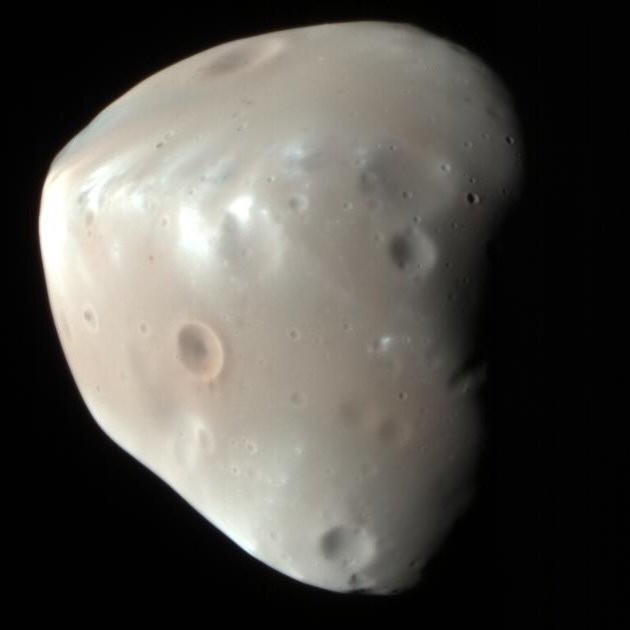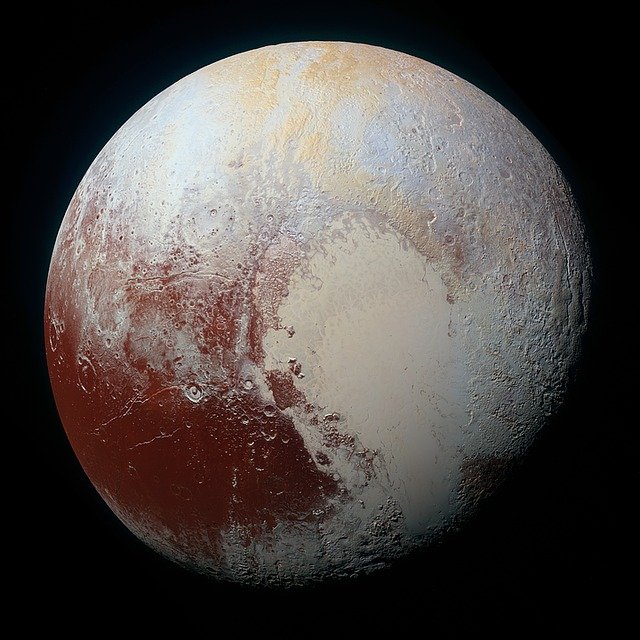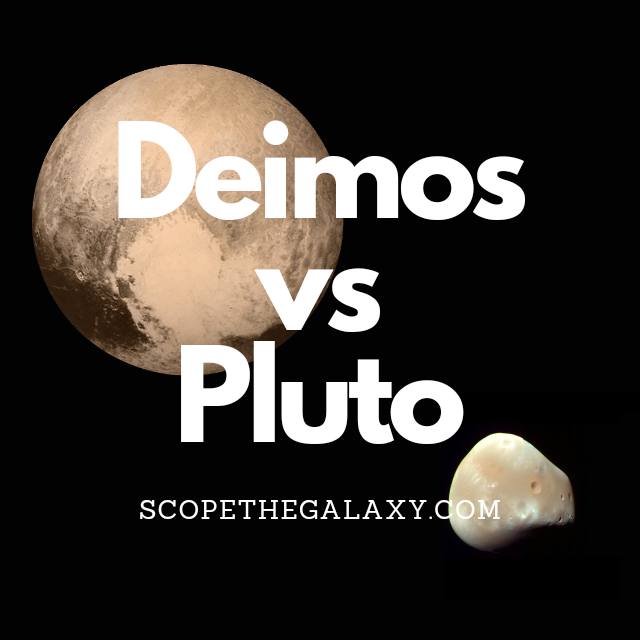*This post may contain affiliate links. This means we may make a commission if you purchase an item using one of our links*
The main differences between Pluto and Deimos are that Pluto is a dwarf planet while Deimos is a natural satellite, Pluto has 5 moons orbiting it while Deimos has 0, Deimos is far smaller with a diameter of 12.4km compared to Pluto’s 2,370km and Pluto is a spherical shape while Deimos is not.
There are a variety of other factors that differentiate these two from one another so continue reading if you want a more detailed look at both bodies along with their similarities and differences below.
What Is The Moon Deimos?
Table of Contents

Deimos is the smaller and outermost of the two moons of Mars, named after the Greek God of dread and terror (the brother of Phobos). This satellite was also discovered by American astronomer Asaph Hall just five days before Phobos (12th August 1877).
Scientists like Johannes Kepler had put forward theories for the existence of these moons many years before they were discovered. Their calculations were based on the fact that the planets on either side (Earth and Jupiter) possessed one and four moons, respectively.
Still, none were discovered until the 19th century. One of the main reasons for this is that the tiny size of Phobos and Deimos, combined with an exceptionally close orbit to their planet, means that the glare of Mars often obscures our view of them.
Phobos measures just 15 x 12 x 11 km and completes an orbit of Mars once every 30 hours.
This tiny moon is also a heavily cratered landscape shaped by the impact of asteroid collisions over time. However, the material thrown up from these impacts doesn’t appear to have landed back on the moon’s surface as it usually would. This could be because the lack of gravity on Phobos allowed the ejected material into space.
The surface gravity on Deimos is just 0.003 m/s^2 (compared to 9.807 m/s^2 on Earth), which means the average gravitational pull of Deimos is only 0.003 m/s. With only 1/2500th of Earth’s gravity, you would need a tether to walk on this rocky moon, or every step would put you at risk of achieving escape velocity and launching yourself into space.
The composition of Deimos is similar to Phobos, suggesting that it might also be a captured asteroid. Its surface is very dark gray and has an albedo of around 0.07, meaning it reflects just 7% light (about half of the light Earth’s moon can reflect).
What Is The Planet Pluto?

In the past Pluto was the 9th farthest official planet in our solar system however, in 2006 after many debates between astronomers, the International Astronomical Union officially downgraded it to a dwarf planet.
The reason for this downgrade at the time was primarily down to Pluto simply being very small when compared to every other planet and even the moons orbiting these planets. Pluto’s dwarf status is debated still to this day but, for now it still remains under this dwarf bracket for a planet
Its diameter for example is only 2,370km, which is a third of Earth’s Moon. With that being said, despite the significant size discrepancy Pluto shows, it still does have more moon like objects orbiting it than Earth and I’m not saying just one more.
In total this terrestrial dwarf planet has 5.
Pluto’s atmosphere consists mostly of molecular nitrogen whilst molecules of methane and carbon monoxide have been observed also. As for its surface, it consist mostly of frozen nitrogen, methane, and carbon monoxide ices.
One of Pluto’s most unique characteristic is that Charon (its largest moon) is tidally locked to it and vice versa, which means that the two essentially orbit each other.
In essence only one side of Charon and one side of Pluto surface will face each other at any given time.
Pluto’s temperature is between -222 to -232 degrees Celsius based on how close it gets to the Sun when orbiting it, whilst its core temperature isn’t anything too special sitting around 500 – 1,000 degrees Celsius.
The main reason it’s as cold as it is and has a relatively cold core in comparison to the other planets would be, which is mostly down to its size. A larger size would mean more mass could be compressed at the center which would produce more heat at the core.
Pluto’s orbit is also different from the other main plants in our solar system, following an elliptical orbital path as opposed to the circular path the others take. As a result of its distance from the Sun, Pluto will complete each one of these elliptical cycles around once every 247.78 years.
Even its rotational cycle is very slow, where one cycle is completed in 157 hours. Another interesting fact is the Pluto’s axial tilt is almost on its side at 57 degrees, similar to Uranus.
Similarities Between Deimos And Pluto
Pluto and Deimos do share a few similarities, which includes the following:
- Both have a hotter central core.
- Both have a rocky, terrestrial surface.
- Neither have rings surrounding them.
- Both are tidally locked entities.
- Both orbit their respective celestial objects in an elliptical pattern.
- Neither have a magnetic field.
- Neither have tectonic plates
Differences Between Deimos And Pluto
As for the differences between the two, they include the below.
- Deimos orbits Mars whilst Pluto only orbits the Sun.
- Pluto has 5 moons orbiting it while Deimos has 0.
- Pluto is a spherical shape while Deimos is not.
- Pluto is a terrestrial planet whilst Deimos is a terrestrial based natural satellite.
- Pluto has a diameter of 2,370km whilst Deimos has a diameter of 12.4km.
- Deimos has no atmosphere whilst Pluto’s atmosphere is composed mostly of nitrogen, methane, and carbon monoxide.
- A day on Deimos takes 30 hours whilst a Pluto day takes 153 hours.
- It takes Deimos 30 hours to orbit Mars and around the Sun in 687 days whilst Pluto orbits the Sun in 247.78 years.
- Deimos’ temperature ranges between -4 to -112 degrees Celsius whilst Pluto has an average temperature of -222 to -232 degrees Celsius.
- Pluto’s density is 1.88 g/cm³ whilst Deimos density is 1.47 g/cm³.
- Pluto’s mass is 1.309 x 10^22 kg whilst Deimos’ mass is 1.4762 × 10^15 kg.
- Deimos’ gravitational strength is 0.003 m/s² whilst Pluto’s is 0.62 m/s².
- Pluto has an axial tilt of 57 degrees whilst Deimos’ is practically 0
Summary
Pluto and Deimos do have a few similar features such as the fact both orbit their planets in a drastic elliptical orbit and are tidally locked to another entity but, they’re very different from each other too.
Whether it be in regards to size, mass, their physical shape, axial tilt and even their composition so, in the grand scheme of it all Pluto and Deimos are very much their own easily recognisable and distinct entities.

